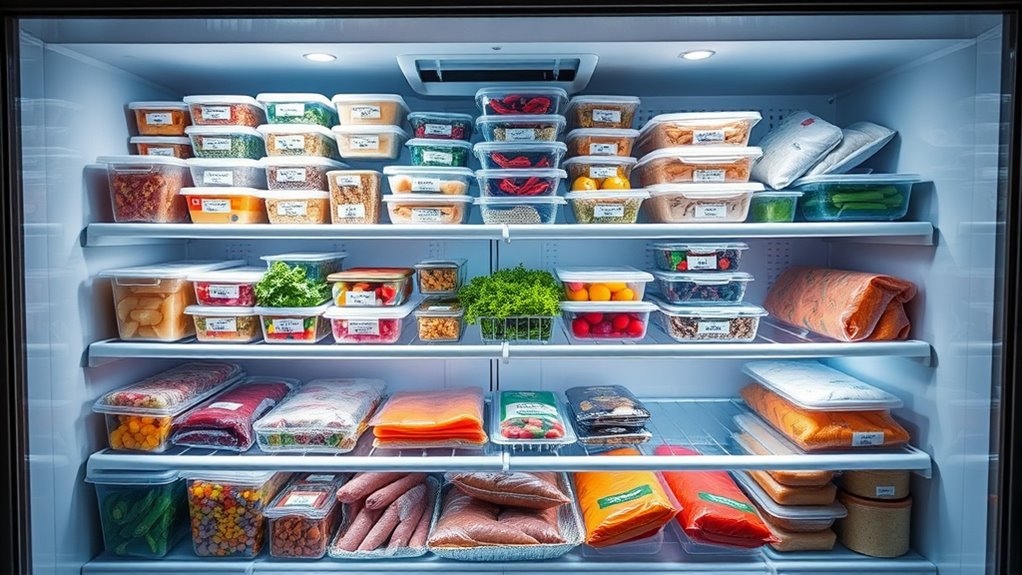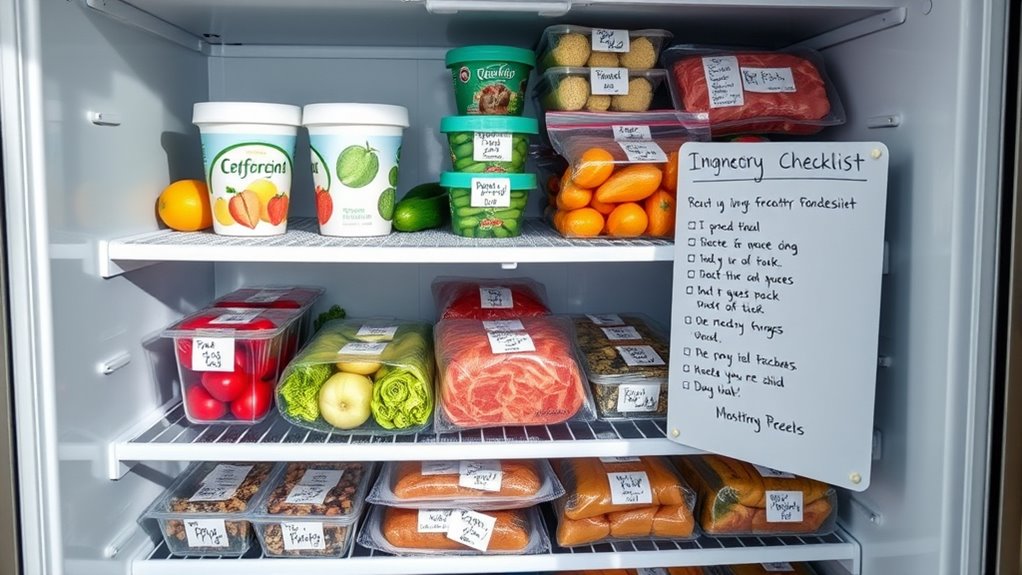Creating a detailed freezer inventory helps you identify what’s inside and prevents mystery meals. By tracking items, quantities, and storage dates, you’ll know exactly what’s available, reducing waste and avoiding last-minute searches. Labeling everything clearly and updating your list regularly keeps your freezer organized and accessible. With a solid system, you can plan meals confidently and minimize unknown leftovers. Keep exploring to discover simple ways to set up your perfect freezer organization.
Key Takeaways
- Maintain a detailed, up-to-date freezer inventory to know exactly what ingredients and meals are available.
- Label all items with date and contents to prevent confusion and identify older items for timely use.
- Organize the freezer into sections (meats, vegetables, meals) for quick access and better visibility.
- Regularly update your inventory before shopping or cooking to avoid forgotten or duplicate items.
- Use digital tools or spreadsheets to track quantities, freeze dates, and plan meals around existing supplies.

Keeping a freezer inventory is essential for managing your food storage efficiently. When you know exactly what’s in your freezer, you can plan meals better, reduce waste, and avoid those frustrating moments of opening the door and wondering what’s hidden deep inside. Without a proper system, it’s easy to forget about frozen leftovers, forgotten ingredients, or random bags of half-used items. An organized inventory helps you stay on top of your supplies and makes meal prep faster and less stressful.
Keeping a freezer inventory helps you stay organized, plan meals easily, and reduce food waste effectively.
Start by creating a simple list or spreadsheet that details everything in your freezer. You don’t need complex software—just a clear record of what you have. As you add new items, note their names, quantities, and dates. Doing this regularly prevents things from getting buried or forgotten. When you’re ready to cook, you can quickly scan your list to see what ingredients are available, saving you time and preventing last-minute shopping trips or reliance on takeout. Plus, knowing what’s in your freezer allows you to use older items first, reducing waste and saving money.
Labeling is a vital part of maintaining your freezer inventory. When you freeze leftovers, meats, or prepped ingredients, use airtight containers or freezer bags and mark the date and contents clearly. This way, you’ll never mistake a frozen steak for a bag of mixed vegetables. Proper labeling helps you identify items at a glance and keeps your inventory accurate. It’s also helpful to organize your freezer by grouping similar items—meats together, vegetables in one area, prepared meals in another. This organization makes it easier to find what you need without rummaging through everything.
Another key benefit of a freezer inventory is reducing mystery meals. When you don’t keep track of what’s in your freezer, you end up with a collection of random items that don’t always come together into a meal. By knowing what you have on hand, you can plan meals around those ingredients, making cooking more straightforward. For instance, spotting a bag of chicken breasts, some frozen spinach, and a box of rice on your list might inspire a quick stir-fry. This approach minimizes the guesswork and helps you create meals from the ingredients already in your home, saving money and reducing food waste.
Ultimately, maintaining a freezer inventory transforms your approach to food storage. It turns a chaotic collection of frozen items into a well-organized, functional system. You gain confidence in your meal planning, avoid unnecessary shopping, and enjoy the satisfaction of knowing exactly what you have at your fingertips. With a little effort upfront, you’ll find that you spend less time searching and more time enjoying your meals. Additionally, understanding cookie policies can help you better manage your privacy preferences while organizing your online tools for inventory management.
Frequently Asked Questions
How Often Should I Update My Freezer Inventory?
You should update your freezer inventory at least once a month to keep track of what’s available and prevent forgotten items. Whenever you restock or use items, make it a habit to update your list. This way, you’ll always know what’s in your freezer, avoid overbuying, and save time when planning meals. Regular updates make managing your freezer easier and ensure nothing goes to waste.
What Tools Are Best for Organizing My Freezer Inventory?
You can keep your freezer organized with simple tools like a magnetic dry-erase board or clear storage bins. These solutions are practical and easy to update, unlike complicated apps that require constant syncing. Use labels to identify contents quickly, and consider a clipboard or printed inventory list for quick reference. These tools help you see everything at a glance, preventing mystery meals and saving you time during busy days.
How Can I Prevent Freezer Burn on Stored Items?
To prevent freezer burn, you should tightly wrap your food in aluminum foil or plastic wrap, then place it in airtight containers or freezer bags. Remove as much air as possible from bags before sealing. Label everything with dates to track freshness. Keep your freezer at 0°F (-18°C) or below, and avoid opening it frequently to maintain a consistent temperature. These steps help keep your food fresh and freezer burn-free.
Is There a Recommended Method for Labeling Frozen Foods?
You should embrace clear, consistent labeling to keep your freezer adventures smooth. Use waterproof markers or labels that resist moisture, and write the date, contents, and any special notes. Place labels on the top or side of packages for easy reading. This way, you’ll effortlessly navigate your frozen treasures, avoiding the mysterious, forgotten items and turning your freezer into a well-organized treasure chest.
How Long Can Different Foods Stay Fresh in the Freezer?
You can generally keep most foods in the freezer for 3 to 6 months to maintain freshness, but some items last longer—meat up to a year, seafood around 6 months, and baked goods up to 3 months. Always label items with dates, and check for signs of freezer burn or off smells before using. Proper packaging and consistent temperature help extend their shelf life and keep your meals tasting fresh.
Conclusion
Keeping a well-organized freezer can reduce food waste by up to 30%, saving you money and time. With a clear inventory, you’ll always know what’s available, preventing mystery meals and last-minute trips to the store. Imagine opening your freezer and effortlessly finding what you need—no more guesswork or forgotten leftovers. Start your freezer inventory today and enjoy a clutter-free, stress-free kitchen. It’s a simple step that makes a big difference!









